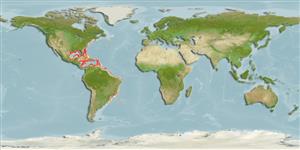Environment: milieu / climate zone / depth range / distribution range
Ekologi
marina djupbottenlevande; djupintervall 326 - 2304 m (Ref. 37039). Deep-water
Western Central Atlantic: North Carolina, USA to Suriname, including the Gulf of Mexico and the Caribbean Sea.
Size / Vikt / Age
Maturity: Lm ? range ? - ? cm
Max length : 109 cm TL hane/ej könsbestämd; (Ref. 37039)
Ryggkotor: 200 - 205. Other characteristics: Color brown to gray, with vertical fins edged in black and stomach and intestine black. Lateral line to anus number 60-64.
Minimum depth from Ref. 58018.
Life cycle and mating behavior
Maturities | Reproduktion | Spawnings | Egg(s) | Fecundities | Larver
McEachran, J.D. and J.D. Fechhelm, 1998. Fishes of the Gulf of Mexico. Volume 1: Myxiniformes to Gasterosteiformes. University of Texas Press, Austin. 1112p. (Ref. 37039)
IUCN Red List Status (Ref. 130435)
Threat to humans
Harmless
Human uses
Verktyg
Special reports
Download XML
Internet-källor
Estimates based on models
Preferred temperature (Ref.
123201): 4.6 - 10.7, mean 6.1 °C (based on 217 cells).
Phylogenetic diversity index (Ref.
82804): PD
50 = 0.5312 [Uniqueness, from 0.5 = low to 2.0 = high].
Bayesian length-weight: a=0.00089 (0.00036 - 0.00223), b=2.98 (2.77 - 3.19), in cm total length, based on LWR estimates for this (Sub)family-body shape (Ref.
93245).
Trofisk nivå (Ref.
69278): 3.5 ±0.5 se; based on size and trophs of closest relatives
Resiliens (Ref.
120179): Låg, lägsta populationsfördubblingstid 4,5-14 år (Assuming tmax>10).
Fishing Vulnerability (Ref.
59153): High to very high vulnerability (65 of 100).
